Key takeaways
- Activist teacher resources promote critical thinking about social justice and encourage meaningful classroom dialogue.
- TeacherPayTeachers (TPT) empowers educators by providing diverse teaching materials, though quality may vary, requiring careful selection.
- Feedback from other educators on TPT enhances trust and confidence in resource choices, especially for activist content.
- Choosing resources should involve reflection and adaptability to ensure alignment with activist teaching goals and student needs.

Understanding Activist Teacher Resources
Activist teacher resources go beyond typical classroom materials; they challenge us to think critically about social justice, equity, and inclusion. I remember the first time I used a lesson plan aimed at dismantling stereotypes—I felt both inspired and nervous, questioning whether I was doing enough to support my students’ diverse experiences.
Have you ever wondered what makes a resource ‘activist’? In my experience, it’s the way these materials encourage dialogue and reflection, pushing students to question the status quo rather than simply memorize facts. These resources feel alive—they spark meaningful conversations that stay with both teachers and students long after class ends.
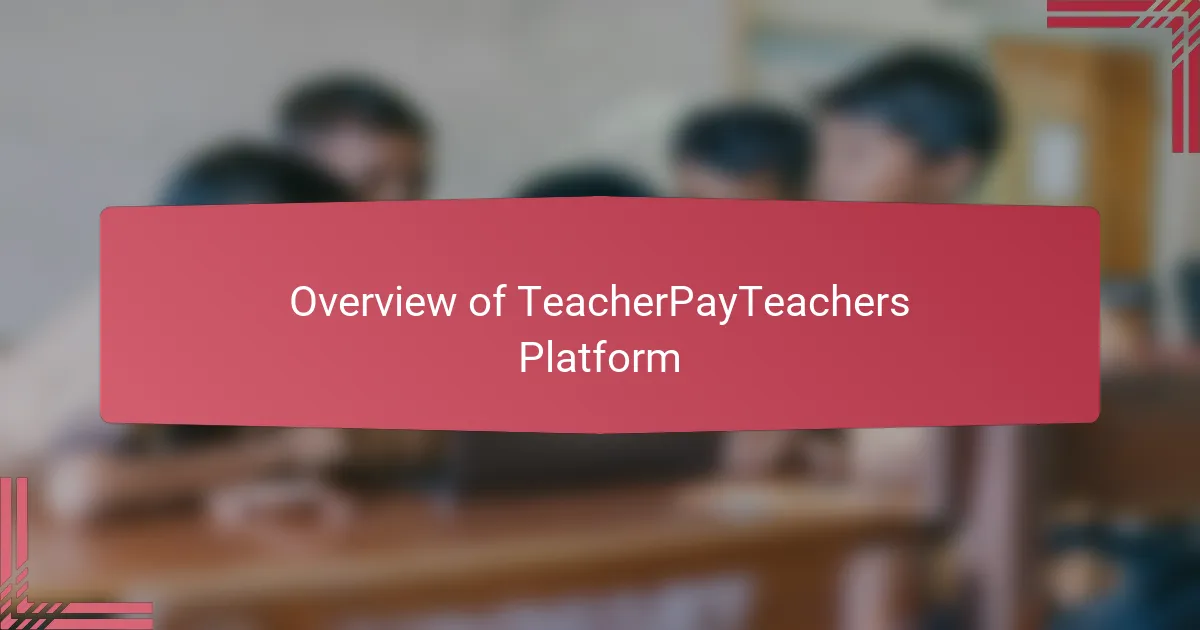
Overview of TeacherPayTeachers Platform
TeacherPayTeachers, often called TPT, is an online marketplace where educators share and sell their own teaching materials. When I first discovered it, I was impressed by the variety—anything from worksheets to full unit plans, catering to every grade and subject imaginable. It felt like a treasure trove for someone looking to diversify their lessons quickly.
But have you noticed how the platform empowers teachers as creators, not just consumers? I appreciate that it allows educators like me to contribute original content, making the process feel collaborative rather than one-sided. At the same time, navigating the sheer volume of resources can be overwhelming; you really have to sift through to find gems that align with your teaching philosophy.
One thing I’ve learned is that TPT is more than just a tool for convenience—it reflects the evolving nature of education itself. Seeing fellow teachers address current issues through their resources confirmed for me how vital this platform can be in supporting activist teaching. It makes me wonder, though: how do we balance convenience with quality when selecting materials?
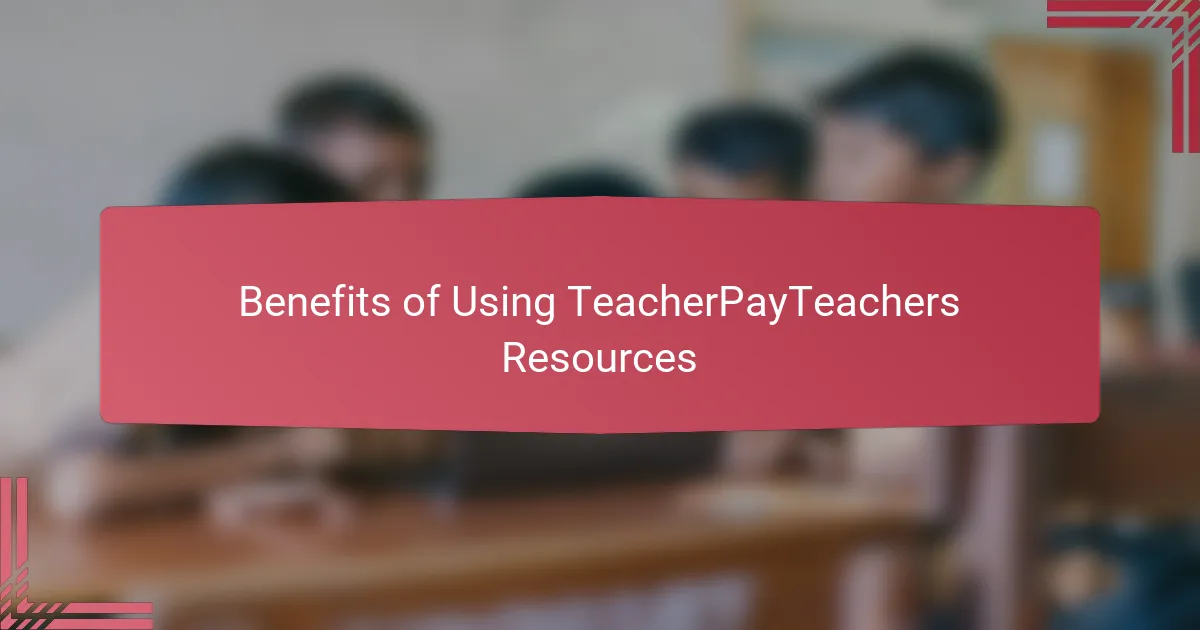
Benefits of Using TeacherPayTeachers Resources
One of the biggest benefits I’ve found using TeacherPayTeachers resources is how they save time without sacrificing creativity. Instead of starting from scratch, I can adapt ready-made lessons that resonate with my activist teaching goals, which feels like a huge relief on busy days. Have you ever had one of those moments where a perfect resource just clicks with your lesson plan? TPT often provides that spark.
Another advantage that stands out to me is the diversity of perspectives in the materials. Since teachers from all over the country contribute, I get access to voices and ideas I might never have found on my own. This makes my classroom discussions richer and more inclusive, which aligns deeply with my commitment to equity. It’s like having a community of educators supporting each other—even when we’re miles apart.
Lastly, the feedback system on TPT adds an extra layer of trust for me. When I’m unsure about a resource, the reviews and ratings by other teachers give me a sense of reliability. Reading honest experiences helps me decide if a lesson is truly activist in spirit or just surface-level. The question I often ask myself is: Does this resource challenge students meaningfully? Thanks to TPT’s community, the answer is often yes.
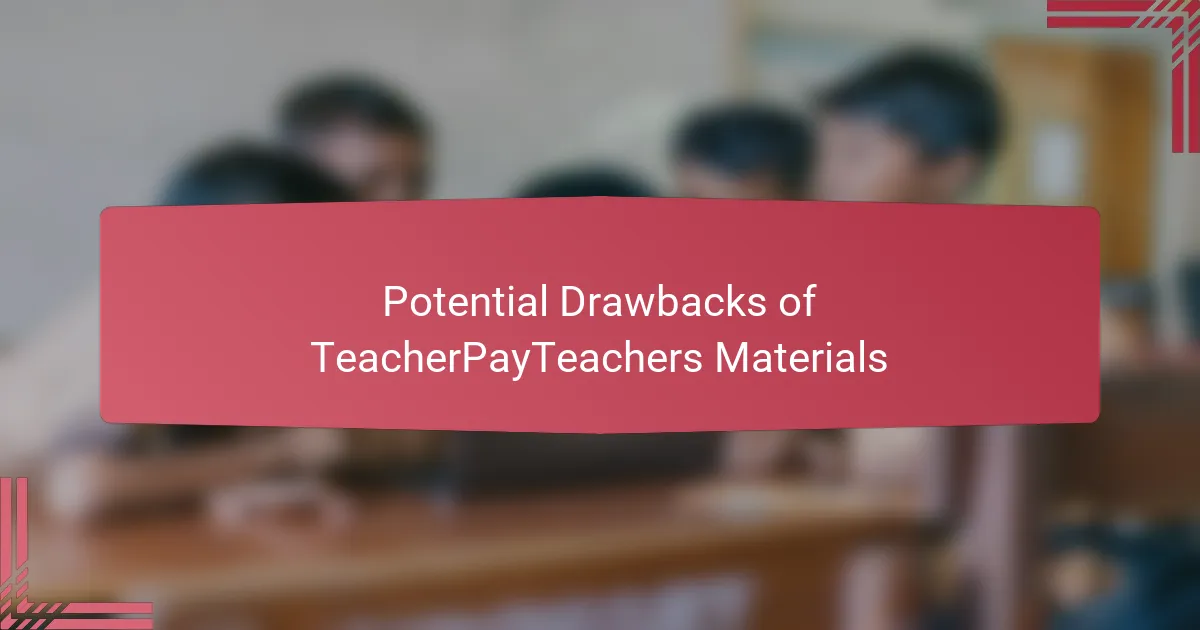
Potential Drawbacks of TeacherPayTeachers Materials
Sometimes, I’ve noticed that TeacherPayTeachers materials can lack consistency in quality. You might find a brilliant lesson plan next to something that feels rushed or generic, which makes me pause and wonder how much vetting these resources really undergo before they go live. Have you ever spent time revising a supposedly ready-to-use activity just to make it fit your activist teaching style?
Another drawback that comes to mind is the challenge of alignment with specific activist goals. While there’s a lot of variety, I sometimes struggle to find materials that deeply address systemic issues rather than just touching on them superficially. It makes me question whether TPT encourages or incentivizes truly critical content, or if the market favors more conventional, less challenging resources.
I also worry about overreliance on paid content, especially for educators with limited budgets. When I first started using TPT, there was excitement about access, but the cumulative costs added up quickly. It made me reflect on how equitable the platform is for teachers working in underfunded schools, and whether those educators miss out on the innovative materials needed to foster social justice conversations.
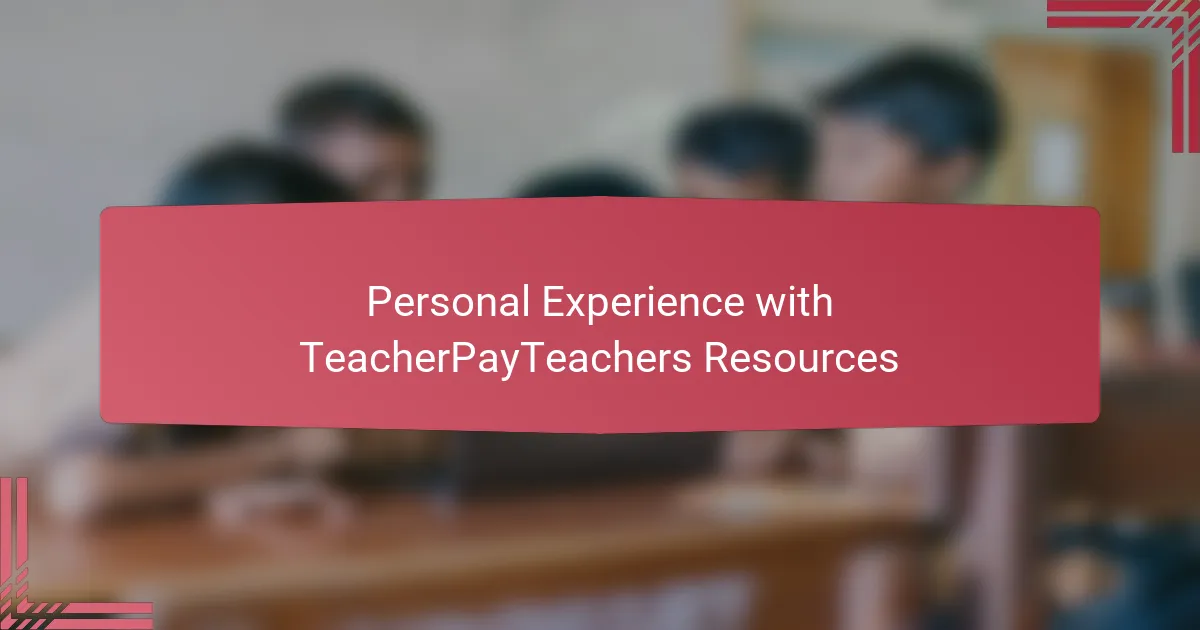
Personal Experience with TeacherPayTeachers Resources
When I first downloaded a TeacherPayTeachers resource focused on social justice, I felt a mix of excitement and caution. The lesson sparked genuine conversation in my classroom, but I found myself tweaking the language to better fit my students’ backgrounds. Have you ever had that moment where a resource almost fits perfectly but needs that personal touch to really land?
Over time, I grew to appreciate how TPT’s resources often serve as starting points rather than finished products. This pushed me to reflect more deeply on my own teaching practice and how I could infuse my activist values into each lesson. It’s like receiving a gift that encourages creativity rather than handing everything over fully formed.
Yet, I can’t ignore the times when I eagerly tried a resource, only to realize it skimmed the surface of important issues. It made me question how we, as educators, can continue advocating for rigorous, meaningful content on platforms driven partly by market forces. Have you faced this tension between inspiration and critical scrutiny when choosing TPT materials? I certainly have, and it keeps me thoughtfully navigating the balance.
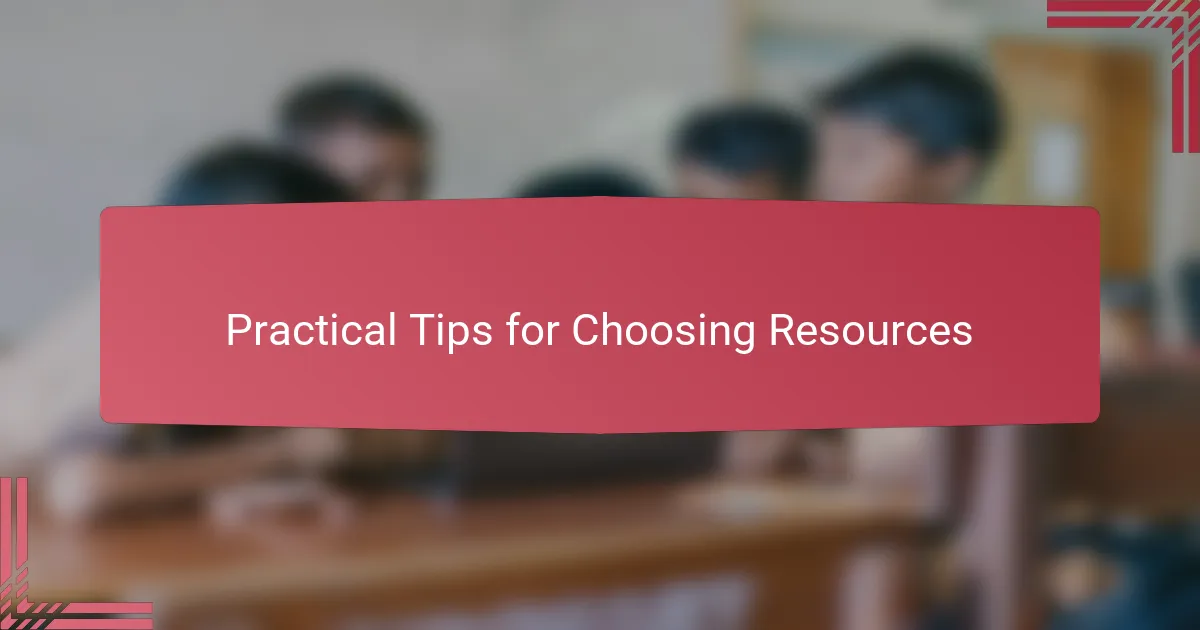
Practical Tips for Choosing Resources
Choosing the right resource on TeacherPayTeachers can sometimes feel like hunting for a needle in a haystack. I’ve found it helps to start by setting clear criteria based on your activist teaching goals—ask yourself, does this material genuinely challenge power structures or just pay them lip service? This question has saved me countless hours and helped me avoid resources that look good on the surface but lack depth.
Another tip I’ve picked up is to dive into the reviews and comments from other educators. Reading their experiences often reveals nuances about how a resource worked in real classrooms, especially for activist content that demands sensitivity and nuance. Have you ever relied on a peer’s honest feedback to decide whether to try a lesson? For me, that community insight is invaluable and gives me more confidence in my choice.
Finally, I suggest thinking about adaptability as a key factor. Even when a resource feels mostly aligned, I’ve learned to anticipate adjustments that make the lesson truly fit my students’ experiences. When you prepare to tweak and make a resource your own, it becomes less about finding perfection and more about starting a meaningful conversation. Have you noticed how this mindset shifts the way you approach teaching materials? I believe it’s a game-changer for activist educators.
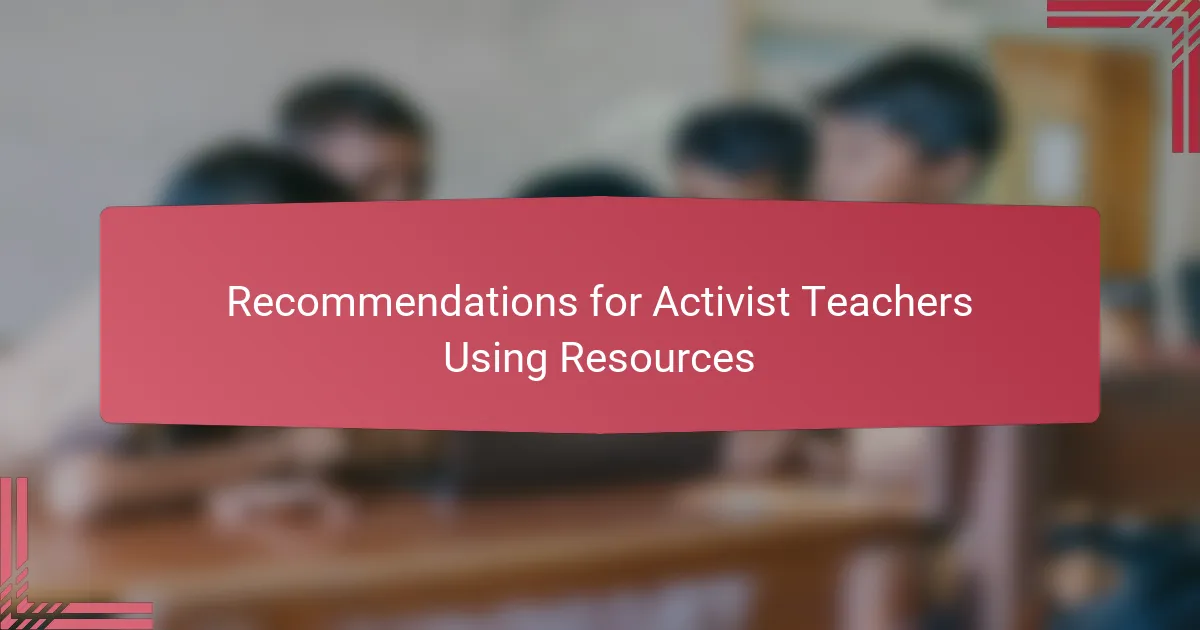
Recommendations for Activist Teachers Using Resources
Selecting resources that truly support activist teaching requires more than a quick download; I’ve realized it’s an ongoing process of reflection and adaptation. Have you ever started with a resource that seemed perfect, only to discover it missed the mark once in your classroom? That’s when I remind myself to remain flexible and willing to reshape the content to better fit my students’ realities.
It also helps to connect with other activist teachers who use these resources—sharing experiences can illuminate potential pitfalls or inspire new approaches I hadn’t considered. When I exchange feedback with colleagues, I often gain fresh perspectives that deepen my understanding of the material’s impact and relevance.
Above all, I recommend prioritizing authenticity and critical challenge over convenience. It’s tempting to grab ready-made lessons that check the boxes, but do they push students to question power and inequality? Asking this sharp question keeps me grounded and ensures the resources I use don’t just talk about change but actively encourage it.